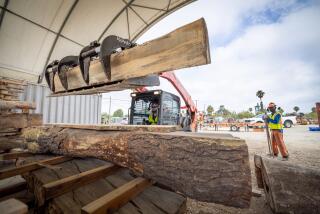San Francisco leads L.A. in scrappy composting race
Jorge Santiesteban estimates that food scraps constitute roughly 15% to 25% of what goes into black garbage bins in Los Angeles. The solid resources manager for the city has been struck by the seasonal changes in how much food we throw away ever since 1997, when a week after Thanksgiving, he had a garbage truck empty its contents for him. Santiesteban picked through the trash, putting like objects with like, until a clear picture emerged. This is what is known in recycling circles as a “waste characterization.”
As bad as it must have been for Santiesteban during that November audit of rotting giblets and pie crusts, his San Franciscan counterpart might have had it worse. Waste characterizations done there show that as much as 30% of San Francisco’s garbage has been composed of food scraps.
Now the race is on to see which of the two cities can divert more kitchen waste from garbage trucks to composting programs. With the introduction of mandatory food-scrap recycling in San Francisco on Oct. 21, the Bay Area has taken the lead.
The challenge began 20 years ago, when overflowing landfills led California to pass the Integrated Waste Management Act of 1989. This required jurisdictions to divert 25% of their trash to recycling programs by 1995 and 50% by 2000. If cities failed, they faced fines of thousands of dollars a day.
It soon became clear that not every city had the same trash profile. While Los Angeles produced huge amounts of lawn clippings, garbage trucks in the more urban San Francisco showed a higher proportion of food scraps.
It only made sense for Los Angeles to work early and hard at getting the lawn clippings out of the black bins. After trial green bins for lawn clippings were introduced in 1993 in the San Fernando Valley, recycling rates went from 7% to 30%. Soon curbside collection of garden trimmings was part of everyday life in Los Angeles.
As the contents of L.A.’s black bins were further characterized, small yellow cartons for bottles and papers were replaced by big blue bins in 1998. Limited largely to newspapers and glass bottles early on, the blue bins now take a variety of items. Santiesteban said the guidelines encourage residents to throw in foam cups and plates, plastic bags, coat hangers and more.
Today, L.A. diverts 65% of its trash from landfill, well above the state average of 59% and the highest recycling rate of all major U.S. cities, Santiesteban said.
This is true provided one doesn’t count San Francisco as a major U.S. city, and L.A. doesn’t. Granted, San Francisco’s population of about 800,000 spread over less than 50 square miles does look puny next to L.A.’s 4 million people over more than 450 square miles. And San Francisco doesn’t take coat hangers or foam cups.
But San Francisco, at 72%, has the higher diversion rate from landfills in the country. Its avowed goal is 75% by next year and zero waste by 2020.
Why the comeuppance for big, sprawling Los Angeles from nimble little San Francisco?
It dates back to L.A.’s 1993 early deployment of green bins, that heroic first move that took lawn clippings out of the black bins. It turns out that not all of the contractors who handle the garden waste collected by the city are licensed to compost food scraps.
Meanwhile, as more urban San Francisco wheels out shiny new green bins at a rate of 100 a day, its system can reach not only apartment dwellers who have never mowed a lawn but also homeowners who have yard waste as well as food scraps. The kitchen and garden waste mix is then delivered to an outfit in the Central Valley that can compost grass clippings and chicken bones -- together.
Restaurants love it, said Jared Blumenfeld, who at the time was director of San Francisco’s Department of Environment. On Thursday he was named director of the Environmental Protection Agency’s Pacific Southwest region.
“The rodent issue for restaurants has gone down because they’re putting the food into containers that are sealed,” he said.
This has to rub. The Los Angeles Bureau of Sanitation has been hosting free kitchen-scrap composting courses and selling discounted home compost bins for years. But these are elective measures, not mandatory. The trucks don’t take bones, meat or dairy. And they will never reach apartment dwellers.
Santiesteban stresses that L.A. does have a pilot food-waste program that includes 8,700 households and an ongoing trial with 800 restaurants. He sees real prospects, particularly with restaurants.
“We have found that a very large percent of what they throw away is organics,” he said, “from 70% to 80%.”
Pending the outcomes of these trial studies, it could be that Los Angeles will have to take a different path with its food scraps, perhaps including them in plans to burn garbage for fuel and count our trash as a renewable energy source.
But back in San Francisco, after the recent raves in the national media for the rollout of its food scrap program, Blumenfeld can’t resist a friendly dig at L.A.
He thinks that Mayor Antonio Villaraigosa’s office can achieve his numbers. The key, Blumenfeld said, is to be tough when issuing Requests for Proposals, or RFPs, when hiring companies to do the city’s composting.
“All they need to say is, ‘We want single-stream recycling. We want food scrap collection program at curbside.’ That’s all it takes,” Blumenfeld said. “That’s the RFP language.”
Villaraigosa’s office said it was not available for comment.
Green’s column on low-water gardening and sustainable landscapes appears weekly on our L.A. at Home blog, latimes.com/home. Comments: home@latimes.com.
More to Read
Sign up for Essential California
The most important California stories and recommendations in your inbox every morning.
You may occasionally receive promotional content from the Los Angeles Times.










